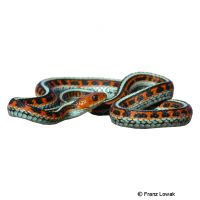California Red-sided Garter Snake (Thamnophis sirtalis infernalis)
| California Red-sided Garter Snake Thamnophis sirtalis infernalis | |
|---|---|
| Name | California Red-sided Garter Snake |
| Name Lat. | Thamnophis sirtalis infernalis |
| Family | Colubrids |
| Family lat. | Colubridae |
| Order | Scaled Reptiles |
| Order lat. | Squamata |
| Origin | California |
| Habitat | Water proximity |
| Diet | Fish, amphibians, rodents |
| Humidity | 50-70 % |
| Behavior | Peaceful |
| Keeping | Individual, pair, group |
| Care Level | Easy |
| Reproduction | Ovoviviparous |
| Housing | Semi-humid terrarium |
| Life Span | 5-10 years |
| Protection | No |
| Metric Units | |
| Size | 40-80 cm |
| Temperature | 20-25 °C |
| Temperature Local | 28-30 °C |
| Housing Size | 110 x 70 x 60 cm |
| US Units | |
| Size | 16"-31" |
| Temperature | 68-77 °F |
| Temperature Local | 82-86 °F |
| Housing Size | 45" x 30" x 25" |
Distribution and habitat
Predominantly diurnal, California red-sided garter snakes are found exclusively in California, along the Pacific coast. They inhabit a variety of habitats, from forests to cultivated lands always near slow-moving or standing water.
Maintenance
Minimum dimensions for the terrarium, according to the size and number of animals:
| 1-2 animals | 1,25KL x 0,75KL x 0,5KL (L x W x H) |
Body length (KL) is measured on the largest animal. For each additional animal the floor space should be increased by 20%. A terrarium of e.g. L 110 x W 70 x H 60 cm is recommended, which should be placed in a quiet and vibration-free place.
They need a terrarium structured with roots, climbing branches, cork tubes and bamboo sticks (hiding places and visual protection) with a moisture-retaining substrate, e.g. of sand-humus mixture with peat and foliage, as well as a large, easy-to-clean water basin as drinking and bathing possibility. Part of the substrate should always be kept slightly moist (no waterlogging). Several times a week, preferably in the evening, the inside of the terrarium should be finely sprayed with water (humidity), but a rain or mist system is better.
| Temp. day: 20-25 °C | Temp. night: 18-22 °C | Temp. local: up to 30 °C | Humidity: 50-70 |
Thermostatically controlled floor heating is recommended. Lighting duration must be 12-14 hrs depending on the season. Daylight fluorescent tubes supplemented with UV lamps are ideal.
Diet
The food supply consists of live fish, lizards, amphibians, earthworms, dewworms and mice according to their size. After successful acclimation, the changeover to dead food animals (commercial frozen food) is often successful. Juveniles should be offered food every 3-5 days, adults every 7-14 days, with occasional periods of fasting (e.g., skipping a feeding). If the snake is disturbed after feeding, this may result in vomiting of the prey. It is better to offer several small feeders, rather than one large one. If it does not eat for a long period of time, both the timing and the food should be varied. It is important to fortify the food animals with vitamins and minerals. Since the snake could be injured by live rodents, it should not be left unattended with them.
Reproduction and breeding
Probing by the veterinarian is the only reliable method of sex determination
The shape of the tail or a thickening in the area of the hemipenis pockets are not definitive sexual characteristics. Garter snakes are viviparous (ovoviviparous). The gestation period is 4-6 months. The young are fully developed at birth and only need to pierce the egg membrane surrounding them. Litter sizes of 5-20 animals are the rule.
Life expectancy can be 5-10 years.
Important
As a breeding form, they are available in different color varieties
They need dry sunny places warmed by radiators. Special attention should be paid to an escape-proof terrarium, as they can squeeze their bodies through the smallest crevices. When threatened, they can emit strong-smelling feces
For the dormancy period, shorten the lighting time by 4-6 hours for 2-5 months and lower the temperature to 10-15 °C, depending on the origin.
Always have snake hooks and protective gloves ready when handling.
The terrarium must have good ventilation without drafts and meet the species specific needs. Measuring devices such as thermometers, hygrometers, etc. are necessary. The lighting has to correspond to the species-specific day-night rhythm and has to be placed in such a way that the animals cannot injure themselves. The terrarium should be locked in such a way that neither unauthorized persons can open it nor the animals can escape. Contamination must be removed regularly
Further literature can be found in your pet store.
References
Text: Christian Sänger; Image: Franz Lowak
Source: BMELV (1997): Tierschutzgutachten - Mindestanforderungen an die Haltung von Reptilien; ENGELMANN (2006): Zootierhaltung - Tiere in menschlicher Obhut: Reptilien und Amphibien, Harri Deutsch Verlag
- Gemäß § 21 Abs. 5 Tierschutzgesetz idgF
